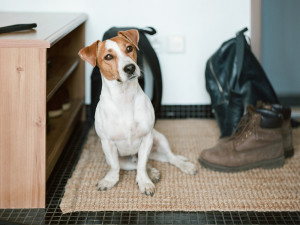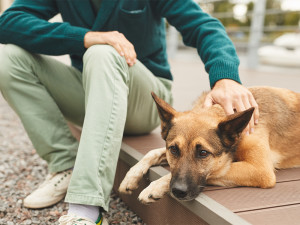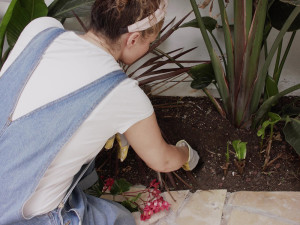Vet Advice and Home Remedies For Dog Scooting
A vet on what to do when “anal sacs go bad.”
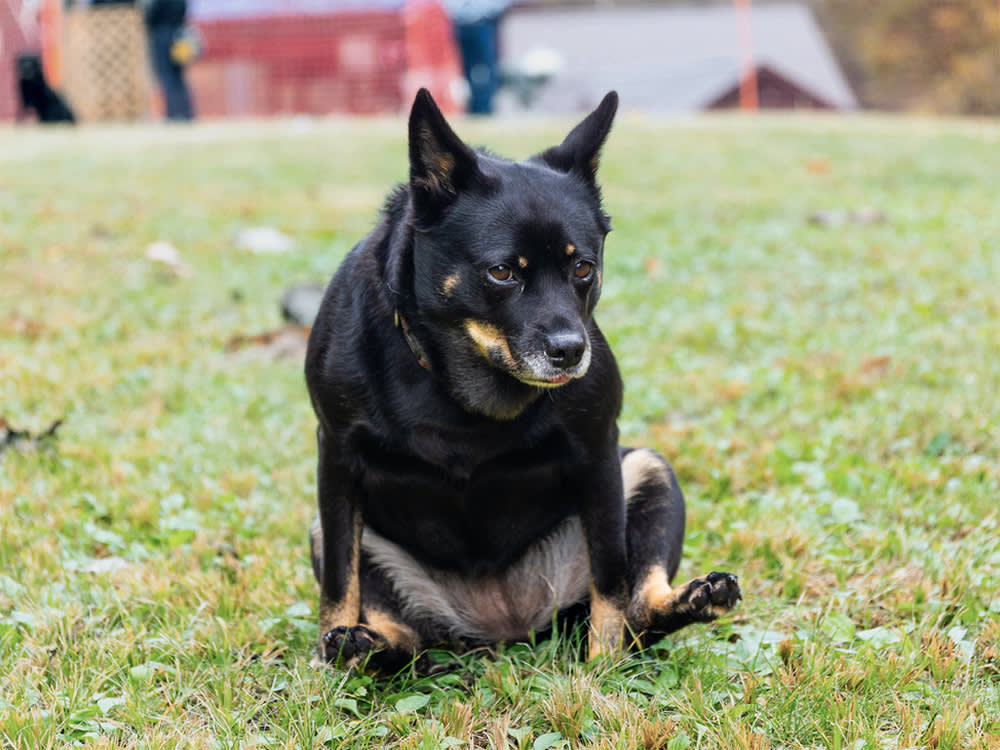
share article

Your pet wants you to read our newsletter. (Then give them a treat.)
When it comes to gross behaviors, your dog scooting their butt across the floor (or on your new rug), definitely tops the list. It may seem funny or weird, but scooting is no laughing matter — in fact, it’s usually a sign of an issue opens in a new tabwith your dog’s anal sacs. They drag their butts across the floor in an attempt to empty their full anal glands. Some dogs will also lick the anal area, while others will nip and bite at their bottom or chase their tails.
Dog anal gland issues are a fairly common problem. Anal sac impaction, aka blockage, most often results in only minor irritation, but if left unchecked, an anal gland abscess (a swollen, pus-filled mass) can develop. Veterinarians usually see ruptured anal glands in the ER. People usually bring their dog in for “bleeding from the rectum” and swelling under their dog’s tail when, in reality, it’s a ruptured anal sac that is draining blood-tinged fluid. It’s what I refer to as “anal sacs gone bad.” Keep reading to learn more about dog scooting, including how to keep your dog’s butt healthy.
What is dog scooting?
Dog scooting is when your dog drags their butt across the floor to try to empty their anal glands. It’s a common behavior that can be caused by a variety of medical and behavioral issues. If your dog is scooting, it's important to take them to the veterinarian to rule out any medical problems. Once any medical issues have been addressed, you can work with your vet to develop a plan to prevent your dog from scooting.
What are dog anal glands?
Canine anal sacs are two grape-sized glands just inside a dog’s anus that contain a foul-smelling brown material. People often describe the dog’s anal gland smell to be “fishy.” Prior to domestication, dogs used the material produced by these glands to mark their territory, emptying the sacs voluntarily.
These days, dogs have largely lost their ability to empty their sacs on demand, but the process occurs naturally during normal defecation when firm feces are passed, lubricating the anal opening in the process. These glands can also “spontaneously empty” during times of stress or excitement; you may recognize this has happened when your dog suddenly develops a very unpleasant odor, or you notice that your dog smells like fish when scared.
How do dog anal abscesses form?
Dog anal sacs become impacted when a blockage develops in the duct that leads from the gland to the anus. The main causes for a blockage in the duct include having a softer stool or diarrheaopens in a new tab, allergiesopens in a new tab that result in inflammation of the sac and duct, or just plain luck of the genetic draw. It is a common misconception that scooting means that a dog has worms. Surprisingly, worms are not a general cause for anal gland swelling.
At this stage, the anal gland is generally swollen and not painful. However, if an anal gland infection develops, the dog’s butt will become painful and swollen and an abscess may form, leading to bleeding from the rectum.
Anal sac infections develop because blockage of the duct results in inflammation of those local tissues. In general, any tissue that’s inflamed is no longer happy and healthy, making it easy for the bacteria that normally live in the area to get out of check and “take over,” causing a bacterial infection.
How are swollen anal glands treated?
A disturbing array of YouTube videos show how to express your dog’s anal glands. This videoopens in a new tab provides a good primer. It may be considered graphic by some, so please don’t click the link if you are easily queasy — some things are best left to professionals.
That said, it is possible to express your dog’s anal glands at home. Obviously, it’s not for everyone, but if you feel comfortable doing so, you can. Please ask your veterinarian or groomer to demonstrate how to do this before you try it for the first time. A second pair of hands up at the front of your dog is helpful to give distracting rubs on the head and praise. A word of caution: Expressing incorrectly can cause irritation and lead to further problems, so make sure you are able to perform the task correctly.
What if your dog continues scooting after treatment?
Your veterinarian should recheck the anal glands if your dog’s scooting behavior continues for more than a couple of days following sac-emptying. If left unattended, an abscess can develop in the gland and rupture through the skin of the rectal region, causing bleeding. A ruptured anal sac abscess is oftentimes mistaken for rectal bleeding. Anal sac abscesses are generally treated at home with antibiotics, pain medications, and warm compresses on the area. Another important reason to take your dog to the vet if the scooting continues is that there could be another issue at play, such as allergies, parasites, or even referred back pain.
If your dog is scooting on a regular basis, and their anal sacs need to be expressed every month or more, you may opt to have the sacs surgically (and therefore permanently) removed. The procedure to remove a dog’s anal glands can be complicated; the sacs are located next to many important nerves — specifically, those that control rectal sphincter function. If improperly performed, your dog could permanently lose control of their bowel function. Despite how scary this sounds, anal sac removal is considered a relatively “simple” surgery by experienced surgeons.
Can I express my dog’s anal glands at home?
Yes, manual expression of anal sacs is possible to do at home. That said, you may want to have a veterinary staff member guide you through it the first time because it can be tricky. Some dogs won't put up a fight, but others will so it's best to have your technique down pat beforehand. It also helps to have another human present so they can keep your pup in place while you work. Here is a step-by-step guide opens in a new tabfor expressing your dog’s anal glands at home.
When should I stop using home remedies and consult a vet?
Some anal gland issues need medical attention. If an anal gland is leaking, noticeably swollen, the skin over the gland is broken, or the gland is hard and cannot be expressed, you should call your vet. These can be signs of a tumor, anal gland infection, or ruptured anal gland abscess.
Are there any natural remedies to prevent scooting?
There are steps you can take at home to help your pup feel better and prevent ongoing scooting. In part, it depends on what is causing them to scoot in the first place. Dogs may scoot if they have impacted anal glands. Some of the reasons this may happen are due to underlying skin allergies and inflammation, anatomical problems with the shape of their glands, or chronic soft stool or diarrhea.
Preventative measures and treatments are aimed at addressing these underlying conditions. Other times, dogs may be scooting for a reason unrelated to their anal glands, including more generalized itchiness or discomfort caused by problems, such as certain intestinal parasites, skin allergies, fleas, poop stuck to their fur around their butt, and more. Some safe options for soothing your pup's butt at home include:
Warm water compress
You can take a wash cloth or paper towel and soak it in warm water and then apply the warm compress directly to your dog’s hind end. Be sure that the water is not too hot and test the temperature on the inside of your elbow first.
Try to hold the compress in place for at least 10 minutes to maximize the benefits. A warm compress helps to enlarge blood vessels near the surface of the skin, increasing circulation, reducing swelling, and recruiting other important cells to the area. It may also help to soften any plugs or crusts that could be blocking the opening of the anal gland ducts. If you see an open wound, skip the warm compress as this area may be too painful to be touched and see your vet right away.
Calendula compresses
Calendula is an extract from the marigold flower that is thought to help with wound healing. Calendula may be soothing for a dog’s anus if they are irritated from scooting a lot. The dried flowers can be steeped into a tea and then that liquid is diluted and used for compressing. If you notice your dog has an open wound or is actively bleeding, be sure to see your vet right away and skip the compress; this area may be very painful to the touch.
More fiber
Since some dogs scoot from impacted anal glands due to chronic soft stool or diarrhea, increasing your pup’s fiber intake may help those cases. In theory, if you can help firm up your dog’s poop, they should be able to compress the glands and empty them when they poop. In most cases, fiber is a safe addition to your dogs diet, so it is unlikely to make things worse, even if it doesn’t stop the scooting.
Some good sources of fiber for your pup include fruits and veggies like sliced appleopens in a new tab with the skin on, pumpkin, broccoli, kaleopens in a new tab, and sweet potatoopens in a new tab. If your vet feels that your dog needs a much higher fiber intake, they may recommend specific supplements and/or specialized diets so be sure to discuss this with your vet. Make sure to introduce fiber slowly in small amounts so your dog has time to adjust. A sudden increase in fiber in their diet can cause gas, bloating, and even diarrhea, so go slow.
Soothing baths
For any dogs with itchy, red, or inflamed skin, or even fur that may be matted with poop, a soothing bath is often a good first step. Use warm but not hot water and consider purchasing a soothing shampoo made specifically for dogs, like an oat-based product, or ask your veterinarian for a recommendation based on your dog's specific needs.
Can I express my dog’s anal glands at home?
Yes and no. While you certainly can learn to safely perform a manual expression of the anal sacs at home, it’s not always a good idea. First, if your dog really doesn’t like having this done, you may not want to be the one your dog associates with this and erode your dogs trust in you. Also, it’s important to only express your dog’s anal glands as directed by your vet. Expressing the anal glands incorrectly or too often can lead to injuries including the build up of scar tissue that will make it even harder for the glands to empty normally. Even if your dog is constantly scooting, it doesn’t mean they always need the glands expressed. It may be one of the many other reasons listed above that is causing them to scoot and treating the underlying problem will be the best approach.
When should I stop using home remedies and consult a vet?
It’s best to consult your vet first before starting the home remedies listed above. This will help you get a clear diagnosis for why your pet is scooting. In some cases, there may be a more specific treatment that your pup needs to resolve the problem, or a more serious condition that needs to be addressed right away.
In other cases, once your vet helps you figure out the underlying cause, you can better tailor your home remedies to your pup’s needs. And certainly, if you see that your pup seems to be in pain, has any open or bleeding wounds, or has other signs of illness including decreased appetite, lethargy, vomiting, diarrhea, difficulty breathing, or anything else that has you worried, see your vet right away.
FAQs (People also ask):
Can home remedies replace veterinary care for scooting?
No. There is always an underlying cause that needs to be addressed to properly treat scooting. Home remedies provide temporary relief in combination with vet care.
Is coconut oil effective for dog scooting?
No. Coconut oil has no effects on scooting and can put dogs at risk for digestive upset and pancreatitis if they ingest the oil.
Can I use over-the-counter creams for my dog's scooting?
In most cases, over-the-counter creams will not help your dog’s scooting and some human products are toxic to dogs. Unless you are using a cream recommended by your vet, do not use these products.
References:
A Cross-Sectional Study on Canine and Feline Anal Sac Diseaseopens in a new tab
Scooting Bums: Prevalence and Risk Factors For Anal Sac Diseaseopens in a new tab
Anal Sacs: a New Approach to an Old Problem?opens in a new tab
Small Animal Dermatology: Diseases of Eyes, Anal Sacs and Ear Canalsopens in a new tab
Diseases of Eyes, Claws, Anal Sacs, and Ear Canalsopens in a new tab
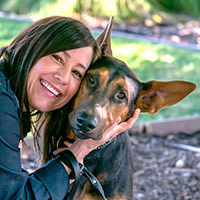
Dr. Shea Cox, DVM, CVPP, CHPV
Dr. Shea Cox is the founder of BluePearl Pet Hospice and is a global leader in animal hospice and palliative care. With a focus on technology, innovation and education, her efforts are changing the end-of-life landscape in veterinary medicine.

Dr. Amy Fox, DVM
Amy Fox, DVM is a small animal veterinarian in New York City. A lifelong animal lover, Dr. Fox studied biology in college and then worked as a veterinary nurse before pursuing veterinary school at Cornell University. She has worked in many different settings including shelter medicine, emergency medicine, general practice, and animal cruelty and forensics. She is especially interested in nutrition, preventative medicine and care for senior pets. Dr. Fox also enjoys writing about veterinary medicine and teaching. In her free time she loves to cook, garden, and go for long runs.
Related articles
![Constipated German Shepherd being comforted by its owner]() opens in a new tab
opens in a new tabGut Feelings: Dogs Get Constipated Too
What to do when your pup can’t poop.
![Fluffy brown and white puppy dog scratching a lot with its paw]() opens in a new tab
opens in a new tabYour Itchy Dog Deserves Relief — Here’s What to Do
How you can help them feel better fast.
![Woman and man petting dog outside]() opens in a new tab
opens in a new tabWhy Dogs Demand Butt Scratches
When your dog looks back at it, you know what to do.
![Brown terrier dog scratching its ear outdoors]() opens in a new tab
opens in a new tabRelief for Your Dog: Discover Effective Solutions for Their Seasonal Allergies
A vet explains why environmental allergies flare up and what to do about it.
![A woman digging a big hole in her flower bed]() opens in a new tab
opens in a new tabHow to Compost Your Pet’s Poop
Without getting totally grossed out.
![Constipated German Shepherd being comforted by its owner]() opens in a new tab
opens in a new tabGut Feelings: Dogs Get Constipated Too
What to do when your pup can’t poop.
